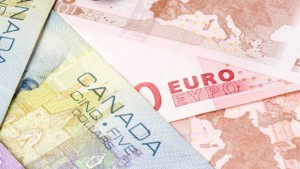 Yesterday’s trade saw EUR/CAD within the range of 1.3468-1.3677. The pair closed at 1.3558, down 0.71% on a daily basis, or the first loss in four trading days.
Yesterday’s trade saw EUR/CAD within the range of 1.3468-1.3677. The pair closed at 1.3558, down 0.71% on a daily basis, or the first loss in four trading days.
At 8:28 GMT today EUR/CAD was down 0.16% for the day to trade at 1.3533. The pair touched a daily low at 1.3513 at 7:05 GMT.
Fundamentals
Euro area
Current Account
At 9:00 GMT the European Central Bank is expected to report on the regions current account balance for January. The seasonally adjusted current account produced a surplus at the amount of EUR 17.8 billion in January, which marked a 34th consecutive month, during which the balance was positive. However, the figure has been the lowest since September 2013, when a surplus of EUR 13.7 billion was reported.
The current account reflects the difference between savings and investments in the Euro area. It is the sum of the balance of trade, net current transfers (cash transfers) and net income from abroad (earnings from investments made abroad plus money sent by individuals working abroad to their families back home, minus payments made to foreign investors).
A current account surplus indicates that the net foreign assets of the region have increased by the respective amount, while a deficit suggests the opposite. A country/region with a surplus on its current account is considered as a net lender to the rest of the world, while a current account deficit puts it in the position of a net borrower. A net lender is consuming less than it is producing, which means it is saving and those savings are being invested abroad, or foreign assets are created. A net borrower is consuming more than it is producing, which means that other countries are lending it their savings, or foreign liabilities are created. A contracting surplus or an expanding deficit on the areas current account usually has a bearish effect on the euro.
Canada
Consumer Inflation
The annualized consumer inflation in Canada probably remained steady at 1.0% in February, according to market expectations. If so, this would be the lowest annual rate of inflation since November 2013, when it was reported at 0.9%. Januarys rate was influenced by an annual drop of 26.9% in prices of gasoline. In December prices plunged by another 16.6%.
Transportation costs decreased for a third consecutive month, down 5.3% during the 12 months to January. This decline was almost entirely attributable to lower gasoline prices. Consumers in the country paid more for passenger vehicles (a 1.2% annual increase) and food (a 4.6% gain year-on-year). In addition, prices of natural gas rose at an annualized rate of 13.9% in January, while shelter costs were up 2.0%, according to the report by the Statistics Canada.
In monthly terms, the Consumer Price Index (CPI) probably rose 0.7% in February, after three consecutive monthly declines.
Key categories in Canadian CPI basket are Shelter (accounting for 27.5% of the total weight) and Transportation (19.3%). Other categories include Food (with a 16.1% share), Household Operations, Furnishings and Equipment (11.8%), Recreation, Education and Reading (11.8%), Clothing and Footwear (5.7%), Health and Personal Care (5%), while Alcoholic Beverages and Tobacco Products comprise the remaining 3%.
Bank of Canadas (BoC) annualized Core CPI, which excludes prices of fruits, vegetables, gasoline, fuel oil, natural gas, mortgages, intercity transportation, and tobacco products, probably increased 2.1% in February. In January and December the annualized core inflation was reported at 2.2%. This is the key measure of inflation, on which the central bank bases its decisions regarding monetary policy. In case the Core CPI decelerated more than projected, this would mount selling pressure on the Canadian dollar. The official CPI report by the Statistics Canada is due out at 12:30 GMT.
Pivot Points
According to Binary Tribune’s daily analysis, the central pivot point for the pair is at 1.3568. In case EUR/CAD manages to breach the first resistance level at 1.3667, it will probably continue up to test 1.3777. In case the second key resistance is broken, the pair will probably attempt to advance to 1.3876.
If EUR/CAD manages to breach the first key support at 1.3458, it will probably continue to slide and test 1.3359. With this second key support broken, the movement to the downside will probably continue to 1.3249.
The mid-Pivot levels for today are as follows: M1 – 1.3304, M2 – 1.3409, M3 – 1.3513, M4 – 1.3618, M5 – 1.3722, M6 – 1.3827.
In weekly terms, the central pivot point is at 1.3513. The three key resistance levels are as follows: R1 – 1.3643, R2 – 1.3871, R3 – 1.4001. The three key support levels are: S1 – 1.3285, S2 – 1.3155, S3 – 1.2927.





